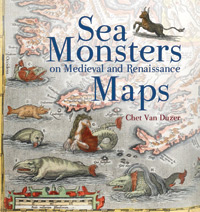Lecture: Sea Monsters
Author Chet Van Duzer Talks About His Book Sea Monsters on Medieval and Renaissance Maps
Although the world’s oceans have been explored in ways early sailors could never have imagined, there are still vast amounts of the deep blue where no human has yet ventured. And it’s within these dark depths that sea monsters live. That’s my theory anyway — and something that medieval and Renaissance folks also believed, as proved by the illustrative cartography of those times. In his recently published book Sea Monsters on Medieval and Renaissance Maps, Chet Van Duzer offers readers a fascinating history of the evolution of unexplained ocean critters as they were perceived hundreds of years ago.

“The sea monsters depicted on maps can offer significant insights into the sources, influences, and methods of the cartographers who drew or painted them,” explains Van Duzer in the introduction to Sea Monsters. “It is important to keep in mind that a number of infrequently seen or large sea creatures — whales and walruses, for example … were considered sea monsters in the Middle Ages and Renaissance.” The illustrations are gorgeous to look at and fancifully rendered as hybrids of land creatures, such as the sea dog, the sea lion, and the sea pig.
“These sea monsters, whether they are depicted swimming vigorously, gamboling amid the waves, attacking ships, or simply displaying themselves for our appreciation, are one of the most visually engaging elements on these maps,” writes Van Duzer. And he is absolutely correct.
4•1•1
Chet Van Duzer will talk about his book Thursday, May 15, at 7 p.m. (members-only reception at 6:15 p.m.), at the S.B. Maritime Museum, 113 Harbor Way. Cost: Free (members), $10 (non-members). To register, call 962-8404 x115 or visit to sbmm.org.



